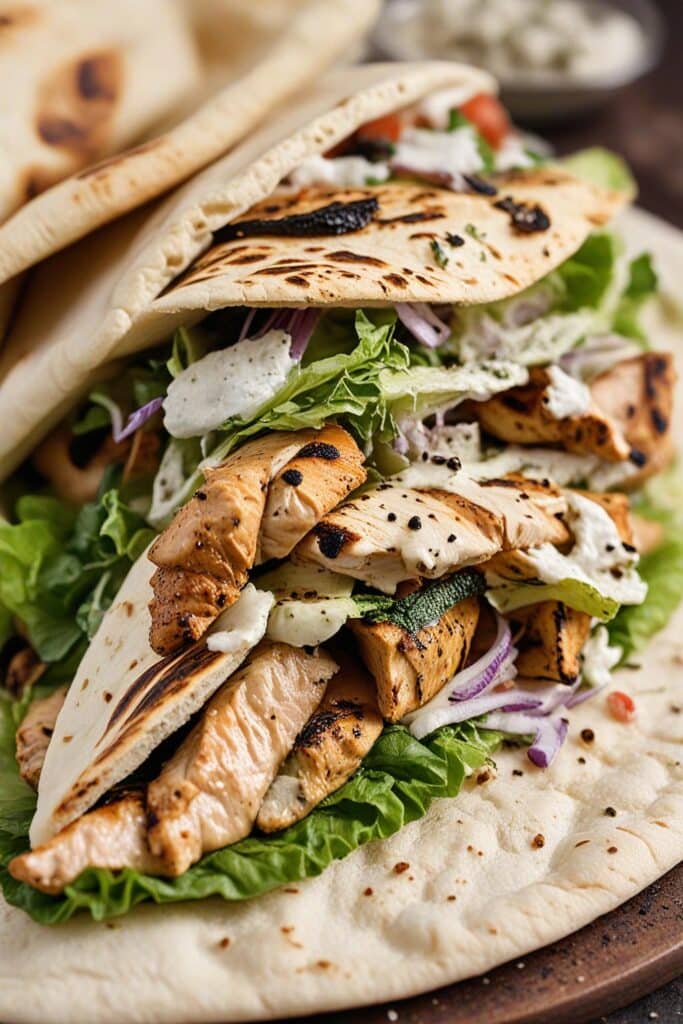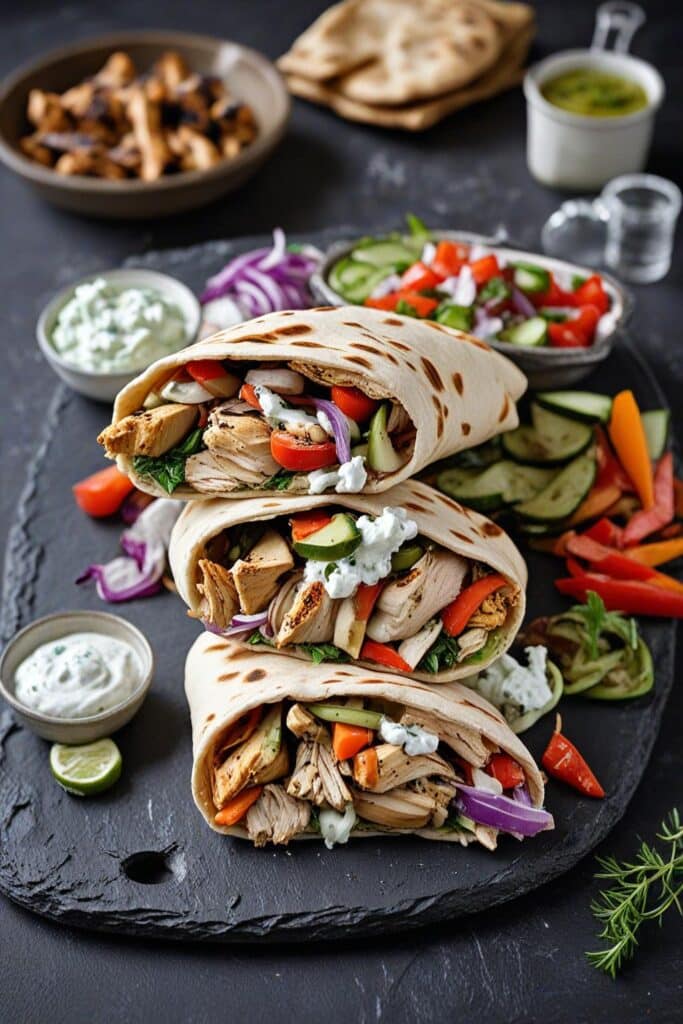Picture this: You’re walking down a narrow cobblestone street in Athens at midnight, the warm Mediterranean air carrying the intoxicating aroma of charred chicken, fresh herbs, and tangy yogurt. That’s the magic I’m chasing every time I craft a proper Greek chicken gyro. After spending three summers working alongside street vendors in Thessaloniki, I learned that authentic gyros aren’t just sandwiches—they’re edible poetry wrapped in warm pita.
The Greek chicken gyro represents everything beautiful about Mediterranean cuisine: simplicity married to complexity, tradition dancing with technique. Unlike it’s heavily-spiced Middle Eastern cousins, the Greek version relies on the holy trinity of lemon, oregano, and olive oil to transform humble chicken into something transcendent. What makes this dish truly special isn’t just the marinade—it’s the understanding that every element, from the pita’s texture to the tzatziki’s temperature, must harmonize perfectly.
Understanding the Foundation: What Makes a True Greek Gyro
Traditional gyros were originally made with lamb or pork, slow-roasted on massive vertical spits that became the heartbeat of Greek street food culture. Chicken gyros emerged as a lighter, more accessible option that still honors the core principles of Greek cooking. The key lies in the marinade’s acid-to-oil ratio and the cooking method that creates those coveted caramelized edges while keeping the interior impossibly tender.
Most home cooks make the mistake of treating gyro chicken like grilled chicken breast. That’s missing the point entirely. The chicken should be sliced thin, marinated deeply, and cooked at high heat to mimic the crispy exterior that develops on a traditional spit. The meat needs to achieve what Greeks call “kaimeni”—that perfect balance of charred and juicy that makes you close your eyes on the first bite.
Ingredients & Substitutions
For the Chicken Marinade:
- 2 pounds boneless, skinless chicken thighs (never use breasts—the fat content is crucial)
- 1/2 cup extra virgin olive oil (Greek if possible, the peppery finish matters)
- 1/3 cup fresh lemon juice (about 2 large lemons, Meyer if available)
- 6 garlic cloves, minced fine
- 2 tablespoons dried oregano (Greek mountain oregano is worth seeking out)
- 1 tablespoon fresh oregano, chopped
- 1 teaspoon kosher salt
- 1/2 teaspoon black pepper, freshly cracked
- 1 teaspoon smoked paprika (not traditional but adds depth)
For the Tzatziki:
- 2 cups Greek yogurt (full-fat, strained overnight)
- 1 large cucumber, grated and drained
- 3 garlic cloves, grated on microplane
- 2 tablespoons olive oil
- 1 tablespoon fresh dill, chopped
- 1 tablespoon white wine vinegar
- Sea salt to taste
For Assembly:
- 6 pita breads (preferably Greek-style, thicker than pocket pita)
- 1 large red onion, thinly sliced
- 2 tomatoes, cut into wedges
- 1/2 cup crumbled feta cheese
- Fresh parsley for garnish
- Lemon wedges
Professional Substitution Notes:
If chicken thighs aren’t available, use chicken leg meat—but never breast meat unless you enjoy eating shoe leather. For those avoiding gluten, lettuce wraps work surprisingly well, though you’ll miss the pita’s textural contrast. Coconut yogurt can substitute for dairy-free tzatziki, but add extra lemon juice to compensate for the sweetness.
Greek mountain oregano has an intensity that makes regular oregano taste like grass clippings. If you can’t source it, use half the amount of high-quality dried oregano and double the fresh. For the olive oil, don’t cheap out—the Greeks use it like other cultures use butter, and the flavor impact is massive.
Step-by-Step Instructions

Preparing the Marinade
Start by whisking your olive oil with lemon juice until it’s properly emulsified—this isn’t just mixing, it’s creating an acid suspension that’ll penetrate the meat fibers. Add the minced garlic, oregano, salt, pepper, and paprika. The mixture should smell like a Greek hillside after rain.
Slice your chicken thighs into strips about 1/4-inch thick—this isn’t random knife work, it’s engineering. Thinner pieces marinate faster and cook more evenly, developing better caramelization. Too thick, and you’ll have raw centers with burnt exteriors. Place the chicken in your marinade and massage it like you mean it. The meat should be completely coated, with every surface glistening.
The Marination Process
Here’s where patience becomes your greatest tool. Two hours minimum, but overnight is better. The acid needs time to break down the proteins while the oil carries those Mediterranean flavors deep into the meat. I’ve seen chefs rush this step and wonder why their gyros taste flat—time is an ingredient you can’t substitute.
Crafting Perfect Tzatziki
Grate your cucumber and salt it generously, then let it drain in a fine-mesh strainer for at least 30 minutes. This step separates the amateurs from the professionals. Excess moisture is tzatziki’s enemy—it’ll turn your sauce into soup and make your pita soggy.

Mix the drained cucumber with Greek yogurt, grated garlic, olive oil, dill, and vinegar. The texture should be thick enough to coat the back of a spoon but loose enough to spread easily. Taste and adjust—the balance between tangy, garlicky, and fresh should make your taste buds sing harmony.
The Cooking Technique
Heat your grill or grill pan to medium-high—you want it hot enough to hear the chicken sizzle when it hits the surface. Don’t overcrowd the pan; work in batches if necessary. The chicken pieces should have space to breathe and caramelize, not steam in their own juices.
Cook for 2-3 minutes per side, looking for those golden-brown edges that spell the difference between good and extraordinary. The meat should develop a slight char while staying tender inside. If you’re using a regular pan, don’t move the chicken around—let it develop that crust before flipping.
Assembly: The Art of the Perfect Gyro
Warm your pita bread directly over a gas flame or in a dry pan until it’s pliable and slightly charred. Cold pita is a gyro killer—it’ll crack and fail to hold your beautiful filling. Spread a generous layer of tzatziki down the center, but not too much or everything will slide out the bottom.
Layer your chicken strips over the tzatziki, then add sliced onions, tomato wedges, and crumbled feta. The onions should be thin enough to eat raw but thick enough to provide crunch. Roll the pita tightly from the bottom, tucking in the sides as you go—this is a technique worth practicing until muscle memory takes over.
Cooking Techniques & Science
The magic of gyro chicken lies in the Maillard reaction—that complex chemical process that creates hundreds of flavor compounds when proteins and sugars meet high heat. The thin slicing maximizes surface area for browning while the marinade’s sugars from the lemon juice caramelize beautifully.

Greek cooking philosophy emphasizes ingredient purity over technique complexity. The olive oil doesn’t just add flavor—it helps conduct heat evenly and prevents the lean protein from drying out. The acid in the marinade acts as a natural tenderizer, breaking down tough muscle fibers without making the meat mushy like commercial tenderizers would.
Temperature control is critical. Too low, and you’ll steam rather than sear. Too high, and you’ll char the outside while leaving the inside undercooked. Most home cooks err on the side of too low—don’t be afraid of that sizzle.
Traditional Cooking Methods vs. Modern Adaptations
Authentic gyros cook on a vertical rotisserie, with layers of marinated meat slowly roasting while the outer edges caramelize. Home cooks can approximate this by using thin cuts and high heat, creating similar textural contrasts. Some chefs layer marinated chicken pieces in a loaf pan and roast them, then slice and sear—this method works surprisingly well for large batches.
The key is understanding that gyro isn’t just grilled chicken in pita. It’s about creating contrast: tender interior, caramelized exterior, cool tzatziki, warm pita, sharp onions, and sweet tomatoes. Every element should complement rather than compete.
Serving & Pairing Suggestions
Present your gyros immediately after assembly while the pita is still warm and the chicken retains its sear. I like to wrap the bottom third in parchment paper—it makes eating easier and prevents the inevitable drips from ruining your shirt.
For sides, stick to Greek tradition: crispy Greek fries with oregano and feta, or a simple horiatiki salad with chunks of tomato, cucumber, and olives. The accompaniments should cleanse the palate between bites rather than compete with the gyro’s flavors.
Wine pairings work beautifully—a crisp Assyrtiko from Santorini cuts through the richness, while a light Roditis complements the herbs. Beer lovers should reach for a Greek lager like Mythos or Alpha, though a cold Pilsner works just as well.
Pro Tips for Perfect Results
Never skip the overnight marinade if you have time. The difference in flavor penetration is dramatic. If you’re pressed for time, at least give it two hours at room temperature—the enzymes work faster when not refrigerated.

Control your heat zones if grilling outdoors. Start the chicken over direct heat for the sear, then move to indirect heat to finish cooking through. This prevents the dreaded burnt-outside, raw-inside scenario that ruins many amateur attempts.
Make extra tzatziki—it keeps for days and improves with time as the flavors meld. Plus, you’ll find yourself putting it on everything from roasted vegetables to scrambled eggs.
Troubleshooting Common Mistakes
Dry chicken usually results from using breast meat or overcooking. Thighs are more forgiving, but even they can’t survive excessive heat. If your chicken feels tough, your marinade didn’t have enough time to work its magic.
Soggy pita comes from too much tzatziki or wet vegetables. Drain your cucumber thoroughly and don’t go overboard with the sauce—you can always add more, but you can’t take it back.
If your gyros fall apart, you’re probably overfilling them or your pita isn’t warm enough to be pliable. Less is more when it comes to filling—you want to taste every component, not create an unwieldy mess.
Variations and Creative Adaptations
For a spicier version, add a pinch of Aleppo pepper to your marinade or serve with a drizzle of hot sauce mixed with olive oil. Some Greek cooks add a touch of honey to their marinade for extra caramelization—just a teaspoon per batch.
Vegetarian versions work well with thick-sliced portobello mushrooms or halloumi cheese, both marinated and grilled using the same technique. The key is maintaining that contrast between charred exterior and tender interior.
Regional Variations Worth Exploring
Northern Greek gyros often include a hint of cumin in the marinade, while island versions might feature more fresh herbs. Some tavernas add a splash of ouzo to their marinade for extra complexity—though this should be used sparingly to avoid overwhelming the other flavors.
The Cultural Significance
Understanding gyros means appreciating their role in Greek social life. They’re not just fast food—they’re comfort food that connects generations. Every Greek cook has their own variation, passed down through families and refined over decades of practice.
The communal aspect matters too. Gyros are meant to be eaten fresh, often shared among friends after a night out or during weekend gatherings. The ritual of assembly and immediate consumption is part of the experience—this isn’t meal prep food, it’s live cooking.
Storage and Make-Ahead Tips
Marinated chicken keeps well for up to three days refrigerated, actually improving in flavor. Cook only what you need immediately, keeping the rest marinated for later use. Cooked chicken can be reheated gently in a pan with a splash of olive oil, though it’s never quite as good as fresh.

Tzatziki improves overnight as flavors meld, but consume within three days for best quality. The garlic will intensify over time, so adjust accordingly based on your preferences.
Conclusion
Mastering the Greek chicken gyro requires understanding that authenticity comes from technique, not just ingredients. The interplay between the marinated chicken’s caramelized edges, the cool creaminess of tzatziki, and the warm embrace of fresh pita creates something greater than the sum of its parts.
The beauty lies in the simplicity—no exotic spices or complicated techniques, just quality ingredients treated with respect and understanding. When you nail the marinade timing, achieve proper searing, and balance all the components, you’ll understand why this humble street food has conquered the world.
Remember that practice makes perfect, and every gyro you make teaches you something new about heat, timing, and balance. Don’t be discouraged if your first attempts don’t match your favorite taverna—even Greek grandmothers took years to perfect their technique.
The real secret isn’t in any special ingredient or hidden technique—it’s in caring enough to do each step properly and understanding that great food comes from patience, quality ingredients, and respect for tradition.
Frequently Asked Questions?
Can I make gyro chicken without a grill? Absolutely. A cast-iron skillet or heavy-bottomed pan works excellently for achieving proper caramelization. Heat the pan until it’s smoking slightly, then add your marinated chicken pieces. The key is high heat and not overcrowding the pan—work in batches if necessary to maintain temperature.
What’s the difference between chicken gyro and chicken shawarma? While both feature marinated chicken cooked on vertical spits, Greek gyros typically use a simpler marinade focused on lemon, oregano, and olive oil. Shawarma marinades often include warming spices like cumin, coriander, and cinnamon. The accompaniments differ too—gyros feature tzatziki and Greek vegetables, while shawarma often includes tahini-based sauces and pickled vegetables.
How long can I marinate the chicken safely? In the refrigerator, chicken can marinate safely for up to 3 days. The acid in the lemon juice will continue breaking down proteins, so don’t exceed this timeframe or the texture may become mushy. For best results, marinate overnight—around 12-24 hours gives optimal flavor penetration without over-tenderizing.
Can I freeze marinated gyro chicken? Yes, marinated chicken freezes well for up to 3 months. Freeze in portions that make sense for your household, and thaw completely in the refrigerator before cooking. The texture might be slightly different from fresh, but the flavor will still be excellent. Never refreeze previously frozen chicken.
What if my tzatziki turns out too thin? Thin tzatziki usually results from insufficient cucumber draining or using regular yogurt instead of Greek. If it’s already made, strain it through cheesecloth or a fine-mesh strainer for 30 minutes to remove excess liquid. Next time, ensure you salt and drain the cucumber thoroughly, and use thick Greek yogurt as your base.

Veronica is a passionate food enthusiast with over three years of experience in exploring and writing about diverse cuisines. Her expertise lies in reviewing restaurants, sharing creative recipes, and discovering the latest food trends. As the voice behind FoodieRecap.com, Anju brings fresh perspectives and culinary insights to her audience.
